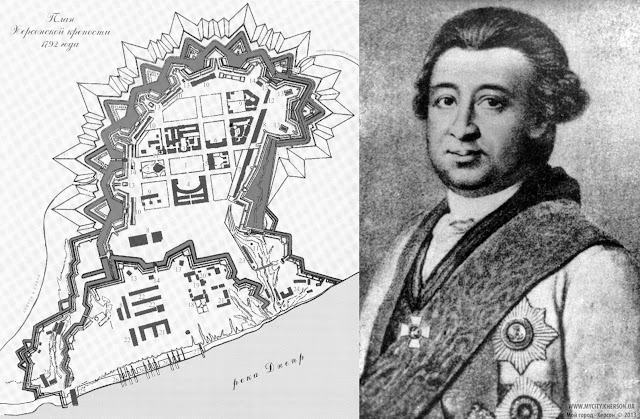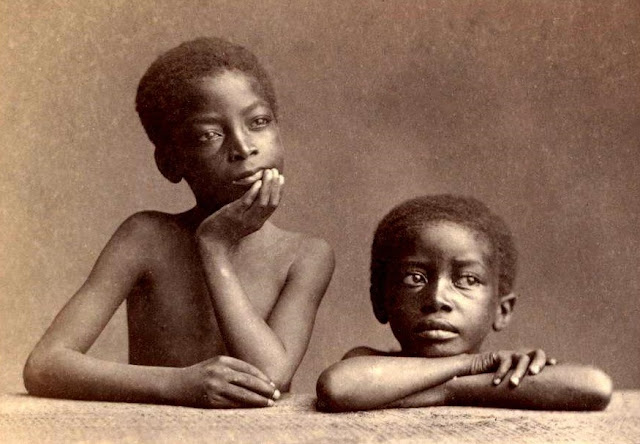The Ukrainian Fortress City Built By A Black Man
The Ukrainian Fortress City Built
By A Black Man
 |
| Left: Plan of the Kherson Fortress in 1792 (Source: Wikipedia Commons); Right: Portrait of General I.A.Hannibal - founder of the city of Kherson and the fortress (Credit: Kherson Guide) |
Many students of Black history are familiar with the name of Benjamin Banneker (1731-1806), the astronomical genius of African descent who contributed to the earliest survey for the construction of the U.S. capital in Washington, D.C. But very few are aware that there was another Black man who supervised a similar project for a city in Europe.
 |
| View of Kherson F. Ya. Alekseev (1755-1824) (Credit: Kherson Guide) |
Kherson, a significant city in Southern Ukraine, was designed and co-founded by the eminent Russian general Ivan Gannibal (1735-1801). Gannibal, it seems, began his work shortly after the city was founded by General Grigory Potemkin, a favorite of Empress Catherine II.
Inside the fortress walls, Gannibal included a majestic palace for the governor general, a great weapons storehouse, shipyards, and post office buildings. Gunpowder cellars, a cathedral, a mint, and a pharmacy were completed later on.
 |
| Portrait of I.A. Hannibal 1780-1790 Dimitry Levitzsky Pavlovsk Museum-Preserve (Source: Bely Gorod "White City" Publishing House) |
For his work, the Russian empress awarded Gannibal the Order of St. Vladimir, first class in 1780 and the Order of St. Alexander Nevsky in 1781, which he may (or may not) be wearing in his ceremonial portrait seen here.
Gannibal's grandfather was an African chief in what is now Cameroon. His father, Abraham, was brought to Russia through the Arab slave trade and, eventually, he also became a top-ranking general. It is clear that Ivan was following in his father's footsteps in so many ways. Both achieved the rank of general-in-chief. Both were amazing architects.
Besides helping to establish Kherson, Ivan is known for a great victory at sea in which he re-took a Russian fort, Navarin, from the Turkish navy.
Alexander Pushkin wrote highly of his great uncle in his 1830 poem "My Genealogy."
He [Abraham Gannibal] was the father of [Ivan] Gannibal,
Before whom, on the seas at Chesma,
Rose a mutltitude of ships,
And for the first time fell Navarin.
Pushkin also included a substantial note on Ivan in his autobiography, which reads as follows:
...Ivan Abramovich is just as worthy of comment as his father. He went into military service against the will of his parent, distinguished himself and, crawling on his knees, begged his father's forgiveness.
Under Chesmoy he ordered firewalls and was one of those who escaped from a ship that flew into the air. In 1770, he took Navarin; in 1779 he built Kherson.
His decrees are still respected in the midday region of Russia, where in 1821 I saw old men who still vividly preserved his memory.
He quarreled with Potemkin. The Empress acquitted Ganibal and put on Alexander’s ribbon; but he left the service and since then lived mostly in Suida, respected by all the wonderful people of the glorious age, among others, Suvorov, who left his mischief under him and whom he accepted without hanging mirrors and not observing any such ceremonies.
'Chesma' and 'Chesmoy' is a reference to another battle in which Gannibal saw action.
 |
| Suvorov speaking with General Gannibal From Illustrated Naval and Military Magazine, Volume 8 (1888) |
'Suvorov' is Alexander Suvorov (1730-1800), who is considered one of Russia's greatest and most well respected generals. That Suvorov had a mutual respect for Ivan as he did for his father is a testament to Ivan's character.
Kherson is now a city of over 330,000 residents according to 2017 estimates. The city mirrors most large cities in the United States in terms of the diversity of nationalities represented in its population.
While there stands a statue and a square in honor of Potemkin - both of which have been restored in recent years - there is no such memorial to Gannibal or his posterity.
 |
| Portrait of Field Marshal G.A. Potemkin Unknown artist of the late 18th century (Credit: Kherson Guide) |
 |
| Tombstone of Field Marshal G.A. Potemkin (Credit: Kherson Guide) |
 |
| Monument to Potemkin in Potemkin Square (Source: Ingvarr) |
Here is an 1876 map of Gannibal's fortress city of Kherson by Russian cartographer Alexey Ilyin Afinogenovich (1832 - 1889).
 |
| City plan of Kherson From Detailed atlas of the Russian Empire with plans of the main cities (1876) (Source: Runivers) |
The fortress itself was constructed according to plans of Mikhail Vetoshnikov, the chief architect of the Admiralty Boards. However, the government of Kherson acknowledges that it was 'General Ivan Hannibal - the son of "The Moor of Peter the Great," who built the fortress and shipyard,' while 'thousands of sailors, soldiers, government and free workers' built majority of the city itself.
The city's website also carries this description of Ivan:
In 1778-1783 he was the commander-in-chief of the Kherson fortress and the builder of the city.
This is what the shipyards in Kherson looked like.
 |
| Diorama "At Kherson Shipyards" (Credit: Kherson Guide) |
Much of the fortress structures lie in ruins. The palace, along with another one intended for the empress, were destroyed in the 1920s. But some aspects of the earliest constructions are still visible today.
Here are views of the gates, which were essentially the main entrance and exit for the city itself.
 |
| Ochakovsky gate of the fortress 1986 (Credit: Kherson Guide) |
 |
| Moscow gate of the fortress 1986 (Credit: Kherson Guide) |
Here is a picture of the arsenal building, which was rebuilt in 1819.
 |
| Artillery Arsenal 1986 (Credit: Kherson Guide) |
 |
| Powder magazine (Credit: Kherson Guide) |
 |
| Saint Catherine Cathedral 1986 (Credit: Kherson Guide) |
Here are some pictures of Kherson I found in a Russian web album by an Igor Chernyshov...
 |
| Bird's Eye View |
 |
| View from a height of 3 km |
 |
| "Three Bayonets" |
 |
| City Center |
 |
| Island |
Here's some views from a hot air balloon.
 |
| Backwaters and boat stations in the area of the cannery (Credit: Kherson Guide) |
 |
| Settlement Steklotarny, Popovich street (Credit: Kherson Guide) |
 |
| Central part of the old city with Suvorov Street in the foreground (Credit: Kherson Guide) |
 |
| View of Sleeping Area (Credit: Kherson Guide) |
 |
| View of Train Station (Credit: Kherson Guide) |
 |
| Microdistrict "Tavrichesky", Vladimir the Great Street (Credit: Kherson Guide) |
Finally, as an added bonus, here is a postcard that I found on the same site with the hot air balloon photos, which demonstrates that Black history in Ukraine long predates the arrival of Ivan Gannibal.
 |
| Lekif figured in the form of a bust of a Black girl Around the second century N. Mykolayiv region (Credit: Kherson Guide) |
The caption reads as follows:
At the beginning of the 20th century, GL Skadovsky, chairman of the Kherson Scientific Archival Commission, carried out the first large-scale archaeological study of an ancient Greek settlement on the island of Berezan. The ancient Boris-Fenida revealed her secrets.
Thanks to the excavations, the ancient collection of the Kherson Museum of Antiquities was replenished.
One of the many exhibits of the Berezan collection is a figured lekif in the form of a girl's bust. Full lips, high eyebrows, a hairstyle of numerous braids - all this suggests that the Greek master ceramist depicted a resident of Africa.
- Omri C.





Comments
Post a Comment